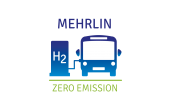
Getting the money for any innovative initiative can be complex and difficult. This is especially so when the initiative is being developed and implemented within a commercial public transport bus operating environment. While money to buy (capital expenditure; CAPEX) and operate (operating expenditure; OPEX) conventional buses is clearly available, additional CAPEX and OPEX associated with the project (for purchase, training, maintenance and other operating costs) will need to be met to fully cover the increased Total Cost of Ownership (TCO). For the PTOs to feel comfortable participating, this extra investment risk needs to be guaranteed by additional funds. Note how-ever, that this will require establishing clarity on the ownership of the FCBs so that costs are correctly allocated.
The major source of this additional money in JIVE and JIVE 2 has been the Clean Hydrogen Partnership that co-funds research and innovation activities. Funds from the Connecting Europe Facility (CEF), which supports infrastructure investment, through the MEHRLIN project (Models for Economic Hydrogen Refuelling Infrastructure) have supported the HRS implementation at several JIVE/JIVE 2 deployment sites.
Various levels of local, regional and national government have also contributed. In some cases, such as in the UK, funding from low emission vehicle and government innovation initiatives has been provided. Some funding, such as for the Groningen project in The Netherlands, has also come as one element of a much broader, energy system or economy wide vision for hydrogen and fuel cells. More recently, funding from private sources has also emerged in some countries. Organisations with new business models are offering "all-in" packaged solutions. Leasing arrangements are also being utilised in newer FCB projects. Finally, while immature, industry may work flexibly with purchasers to help them achieve their goal (see Table 2 7 for links to a sample list of suppliers).
Complicating the process of raising external funding is also the fact that establishing the additional costs that are expected to arise from a FCB project is quite complex at present. Some of these costs may well arise after the end date of the co-funded phase (‘beyond project’ costs), resulting from the potential for ongoing use of the FCBs and HRS up to the end-of-life of the buses. Nonetheless, being able to present reliable cost figures is essential to gain support from stakeholders and for applying for financial support from whatever source. Table 2 1 and Table 2 2 summarise the challenges en-countered, and Best Practice solutions found, with respect to expenditure and funding. Table 2 3 provides useful information for sourcing finance.
Overall, sourcing funds in addition to the Clean Hydrogen Partnership funding has not been easy. No site has found this trouble free, including those that with experience from previous projects. However, there were no patterns that could be identified that could lead to success or problems. Much seemed to depend on specific knowledge of local, regional and national funding programmes, and local circumstances at the time, particularly political circumstances.[1]
Possibly the only common driver for funding is the existence of supra-national (EU) and national targets for emission reduction. These have clearly acted to galvanise action from those involved in the provision of public transport. The pressure in this respect has increased via the revised Clean Vehicles Directive (CVD) that sets out mandatory minimum procurement targets for clean light-duty vehicles, trucks and buses for 2025 and 2030, including zero emission buses.
A challenge for the nearer future will be to move from co-funding models to commercial financing models.
Beyond TCO, it is very beneficial to undertake Life-Cycle Costing (LCC). This considers, (in addition to TCO) costs resulting from the consequences of emitting greenhouse gases (GHG) and other pollutants. These are largely the costs associated with health treatment and climate change impacts as well as mitigation and adaptation policies. The savings achieved by replacing conventional buses with zero emission alternatives can be a useful argument when negotiating for additional funds or, in the future, cheaper loans from government for whom these costs are a large budget item.
The energy crisis in Europe that commenced in the early 2020s also led to increased hydrogen prices at several sites. This highlights that business cases and funding need to be robust, and that price clauses in supply contracts must be well understood.
[1] The Clean Hydrogen Partnership will not fund pure FCB demonstration projects in the future. However, buses and their infrastructure can be co-founded as part of their call for proposals for “Hydrogen Valley” projects with a more comprehensive approach, meant to initiate integrated hydrogen ecosystems. Other options for obtaining financial support for the purchase of vehicles are in place, see Table 2 3.
Challenges and solutions for sourcing finance






